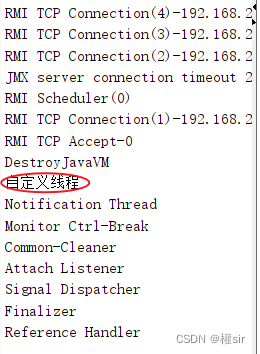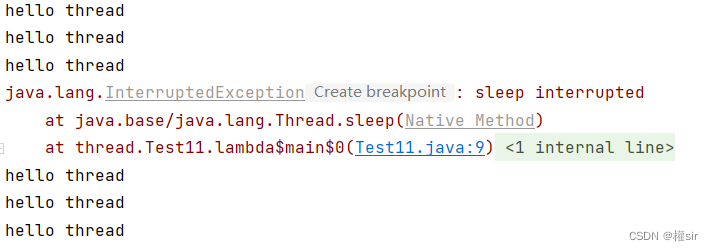文章目录
1、Thread的常见构造方法
| 方法 | 说明 |
|---|---|
| Thread() | 创建线程对象 |
| Thread(Runnable target) | 使用Runnable对象创建线程对象 |
| Thread(String name) | 创建线程对象,并命名 |
| Thread(Runnable target, String name) | 使用Runnable对象创建线程对象,并命名 |
| Thread(ThreadGroup, Runnable target) | 线程可以被用来分组管理,分好组即可 |
前面两个构造方法我们在线程的概念这篇中已经讲过了,这里就不在过多赘述
创建线程对象,并命名和使用Runnable对象创建对象,并命名
举例:
public class Test6 {
public static void main(String[] args) {
Thread thread = new Thread(()->{
while (true) {
System.out.println("hello");
}
},"自定义线程");
thread.start();
}
}
这里我们也可以通过jconsole.exe这个应用程序来观察到

注意:这么没有看到main线程不是main线程没有被创建,而是执行太快,已经执行完毕了
最后一个构造方法,在开发中很少用到,这里不再过多讨论
2、Thread的几个常见属性
| 属性 | 获取方法 |
|---|---|
| ID | getId() |
| 名称 | getName() |
| 状态 | getState() |
| 优先级 | getPriority() |
| 是否后台线程 | isDaemon() |
| 是否存活 | isAlive() |
| 是否被中断 | isInterrupted() |
2.1 ID
ID是线程的唯一标识,不同线程不会重复,这里的ID和系统中PCB上的ID是不同的
2.2 名称
名称是各种调试工具用到
2.3 状态
状态表示线程当前所处的一个情况,后续会再次说明
2.4 优先级
优先级高的线程理论上来说更容易被调度
2.5 是否后台线程
线程有前台线程和后台线程
前台线程:这样的线程如果不运行结束,Java进程是一定不会结束的
前台线程可以有多个,多个前台线程,必须最后一个前台线程结束,进程才可以结束
后台线程:这样的线程,即使继续执行,也不能阻止Java进程结束
在Java代码中,main线程是前台线程,程序员创建出来的线程在默认情况下都是前台线程,我们可以通过setDaemon方法把线程设置为后台线程
举例:
public class Test7 {
public static void main(String[] args) {
Thread thread = new Thread(()->{
for (int i = 0; i < 5; i++) {
System.out.println("hello thread");
}
});
//设置为后台线程
thread.setDaemon(true);
thread.start();
}
}
运行结果:

此时,进程中只有main是前台线程,只要main结束,整个进程就结束了,main执行完start立即结束
此时thread还没来得及打印,进程就结束了,里面的线程也就结束了
注意:这里也有一定的概率,出现thread打印一次,然后结束进程的情况,这个就要看main先执行结束,还是thread先执行一次打印(线程之间是抢占式执行,调度顺序不确定)
判断是否为后台线程:
public class Test7 {
public static void main(String[] args) {
Thread thread = new Thread(()->{
for (int i = 0; i < 5; i++) {
System.out.println("hello thread");
}
});
//设置为后台线程
thread.setDaemon(true);
thread.start();
//是后台线程返回true,不是返回false
System.out.println(thread.isDaemon());
}
}
运行结果:

2.6 是否存活
指的是系统中的线程(PCB)是否存在
Thread对象的生命周期和PCB的生命周期是不一定完全一样的
举例:
public class Test8 {
public static void main(String[] args) throws InterruptedException {
Thread thread = new Thread(()->{
System.out.println("hello thread");
});
//如果PCB存活返回true,不存活返回false
System.out.println(thread.isAlive());
}
}
运行结果:

只有调用thread.start()方法后,才会创建线程,PCB才会在内核中创建出来
代码如下:
public class Test8 {
public static void main(String[] args) throws InterruptedException {
Thread thread = new Thread(()->{
System.out.println("hello thread");
});
thread.start();
System.out.println(thread.isAlive());
}
}

2.7 是否被中断
在Java中,我们可以通过调用Thread类的interrupt()方法来终止线程,这会向线程发送一个中断信号,线程可以通过检查isInterrupted()方法来响应中断并做出相应的处理,通常是安全的终止线程的执行
举例:
public class Test11 {
public static void main(String[] args) {
Thread thread = new Thread(()->{
//currentThread()这是一个static方法,能获取到当前线程,获取到thread这个引用
//isInterrupte()线程内置的标志位 boolean变量 true表示线程终止 false表示线程继续执行
while(!Thread.currentThread().isInterrupted()) {
System.out.println("hello thread");
try {
Thread.sleep(1000);
} catch (InterruptedException e) {
e.printStackTrace();
}
}
});
thread.start();
try {
Thread.sleep(3000);
} catch (InterruptedException e) {
throw new RuntimeException(e);
}
//中断thread线程
thread.interrupt();
}
}
运行结果:

注意这里,即使将thread线程中断了,但是循环还在继续执行,这个是为什么?
thread.interrupt();这段代码干了两件事:
1.将Thread.currentThread().isInterrupted()的布尔值改变为true
2.立即唤醒sleep(),不在等待
sleep()被唤醒的同时,就会清除刚才的标志位(又改回false),从而导致代码中的循环继续执行,同时catch()方法中的代码也会执行
之所以要改回来就是把控制权交给程序员,让程序员自己在catch()方法中设置,假如要中断thread线程,只需要在catch()方法中写break;就可以中断循环,使thread线程结束
3.补充说明
3.1 Thread.sleep()的作用
sleep()这个方法指睡眠/休眠,就是让线程主动进入“阻塞状态”(PCB上的状态属性),主动放弃去cpu上执行,时间到了,就会解除阻塞状态重新被调度到cpu上执行
3.2 Thread.sleep()的异常处理方式
**在main方法中处理sleep异常的方式有两种:
1.throws **
public class Test {
public static void main(String[] args) throws InterruptedException {
Thread.sleep(1000);
}
}
2.try catch
public class Test {
public static void main(String[] args) {
try {
Thread.sleep(1000);
} catch (InterruptedException e) {
throw new RuntimeException(e);
}
}
}
如果是在线程的run方法中只能用:try catch
public class Test {
public static void main(String[] args) {
Thread thread = new Thread(()-> {
System.out.println("hello thread");
try {
Thread.sleep(1000);
} catch (InterruptedException e) {
throw new RuntimeException(e);
}
});
}
}
这是因为throws也是方法签名的一部分,在run方法重写的时候,就要求方法的签名要一样
method sign ature包含:1.方法的名字
2.方法的参数列表(包含了类型和个数)
3.声明抛出的异常





















 2123
2123

 被折叠的 条评论
为什么被折叠?
被折叠的 条评论
为什么被折叠?








